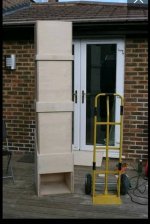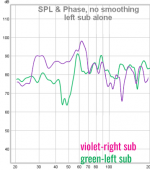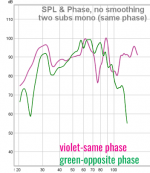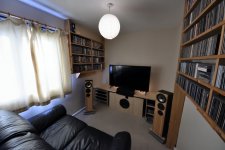Hello All,
What is your preferred way to add a sub-woofer(s)?
I am putting together a stereo system that will not always use a sub-woofer, you know late at night or your wife is reading downstairs kind of thing. Or you are listening to program material that has no Low Frequency Effects. But when you do, you want to kick it up to 11.
I am thinking of speakers without added sub-woofers with an f3 of 40Hz. For most program material they will work just fine without the added benefit of sub-woofers. Just saying, maybe JBL 2226’s, reflex enclosures with 5 ft3 volume tuned to 40Hz. (From the factory data sheet.)
I know some folks have a preference for sealed woofers. Is there a benefit in using sealed woofers when a sub-woofer will be switched in or out?
What kind of trouble will there be in terms of phase and, group delay or other issues if a sub-woofer(s) down to 20Hz is added?
Just trying to stir up a discussion!
Thanks DT
What is your preferred way to add a sub-woofer(s)?
I am putting together a stereo system that will not always use a sub-woofer, you know late at night or your wife is reading downstairs kind of thing. Or you are listening to program material that has no Low Frequency Effects. But when you do, you want to kick it up to 11.
I am thinking of speakers without added sub-woofers with an f3 of 40Hz. For most program material they will work just fine without the added benefit of sub-woofers. Just saying, maybe JBL 2226’s, reflex enclosures with 5 ft3 volume tuned to 40Hz. (From the factory data sheet.)
I know some folks have a preference for sealed woofers. Is there a benefit in using sealed woofers when a sub-woofer will be switched in or out?
What kind of trouble will there be in terms of phase and, group delay or other issues if a sub-woofer(s) down to 20Hz is added?
Just trying to stir up a discussion!
Thanks DT
Text book says that Butterworth type is for sealed. Good integration at crossover happens at -6 dB so it's good to have both. Phase would show that the superimposed sub would rule till, say, 50 Hz, dunno, never played with subsI know some folks have a preference for sealed woofers. Is there a benefit in using sealed woofers when a sub-woofer will be switched in or out?
I have ao the Linkwitz Pluto 2 plus subs.
These are closed speakers and subs, with eq to get a flat frequency responce. The Pluto on its own has a free air f-3dB at 40Hz. With sub they are crossed over at 100Hz. At low levels and normal music I don't hear much difference with or without subs. Integration seems good with this system.
These are closed speakers and subs, with eq to get a flat frequency responce. The Pluto on its own has a free air f-3dB at 40Hz. With sub they are crossed over at 100Hz. At low levels and normal music I don't hear much difference with or without subs. Integration seems good with this system.
Multiple subwoofers iron bass notes. For example, on the picture above the right channel gives good bass response with all notes sounding loud from 25Hz and up. Speaker/sub on the left side have a broad depression between 40 and 80. On music with stereo signal below 100Hz you can feel more energy is coming from the right side.
I downmix to mono sounds below 100Hz to obtain a smoother bass response. With separate subs you can place them where they give the smoothest bass response. Sometimes, inverting one sub's polarity improves bass sound even further.
Multiple subs may not sound louder than one.
So, adding several subs will not make the sound boomy and loud. You'd rather get smoother bass. You will need a good DSP to integrate them.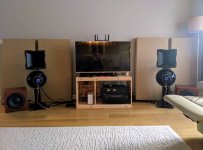
I downmix to mono sounds below 100Hz to obtain a smoother bass response. With separate subs you can place them where they give the smoothest bass response. Sometimes, inverting one sub's polarity improves bass sound even further.
Multiple subs may not sound louder than one.
So, adding several subs will not make the sound boomy and loud. You'd rather get smoother bass. You will need a good DSP to integrate them.

Due to very varying sound quality on music recordings i find it very difficult to get a system response that worked flawless with subs, it was a constant job of setting the low freq level, many in the music business seems not to have a clue how to make good recordings and how to set levels correctly! i got thick of it all and removed the subs. For music i think subs causes just to much pain, woofers that does not dig as deep is better for overall sound quality, and they should be used as high as possible in frequency.
Due to very varying sound quality on music recordings i find it very difficult to get a system response that worked flawless with subs, it was a constant job of setting the low freq level, many in the music business seems not to have a clue how to make good recordings and how to set levels correctly!.
I believe, you should let us know how many subs you had, how were they crossed, processed and what kind of music you listen to. Without these details, your statement "subs are bad for music" is useless.
i had four subs, i mostly listen to jazz, fusion, death metal, and djent. active crossovers. If you have not encounter any level problems with subs and music i wonder if you listen to music at all!? I can tell you, many recordings seems not to go thru any sound quality control at all, and this is a major problem. I wish the music recording business had some of the quality control that movie business has. But home recordings seems to take us further and further away from that target
To prevent the subs canceling each other: put the subs close to each other.
Just like driver spacing with drivers in a single box; the rule is <1/4 or >2 wavelengths from each other and half of that for distances to walls.
Unless the room is really big, the subs are in the corner and at nearby walls. You can stack them if you like and they are fed a mono signal. Sealed has the best SQ and roomgain from the corner will compensate for the roll off on the lower end. A flat sub will sound boomy (to much very lows) due to the room gain.
Your neighbors will also like these tips as you get more effective/efficient bass in your room.
IMO subs under the man speakers is often about as bad as it can be for the bass; probably the most made mistake. Bass has a hear and a feel; good/whole/tight bass does make me feel I wanna move/dance.
Just like driver spacing with drivers in a single box; the rule is <1/4 or >2 wavelengths from each other and half of that for distances to walls.
Unless the room is really big, the subs are in the corner and at nearby walls. You can stack them if you like and they are fed a mono signal. Sealed has the best SQ and roomgain from the corner will compensate for the roll off on the lower end. A flat sub will sound boomy (to much very lows) due to the room gain.
Your neighbors will also like these tips as you get more effective/efficient bass in your room.
IMO subs under the man speakers is often about as bad as it can be for the bass; probably the most made mistake. Bass has a hear and a feel; good/whole/tight bass does make me feel I wanna move/dance.
i had four subs, i mostly listen to jazz, fusion, death metal, and djent. active crossovers. If you have not encounter any level problems with subs and music i wonder if you listen to music at all!? I can tell you, many recordings seems not to go thru any sound quality control at all, and this is a major problem. I wish the music recording business had some of the quality control that movie business has. But home recordings seems to take us further and further away from that target
A simple tone control with tilt and low shelving filters is very useful.
Movie uses a standard, music does not.
i had four subs, i mostly listen to jazz, fusion, death metal, and djent. active crossovers. If you have not encounter any level problems with subs and music i wonder if you listen to music at all!? I can tell you, many recordings seems not to go thru any sound quality control at all, and this is a major problem. I wish the music recording business had some of the quality control that movie business has. But home recordings seems to take us further and further away from that target
Thank you for the clarification. I'm not only measuring, I do listen too
I agree that some older rock records have very little bass and they sound too thin. Some have exaggerated bass (say, Weekend - Starboy). However, if remove the bass from the system at all as you suggest, everything will sound thin and lifeless.
I was able to adjust the bass level to sound good on most music I listen to. Some older rock sounds think, but that's the way it was recorded and meant to sound. So why should I try to fix it? Most of the modern records sound excellent though. Even "Starboy"
Here are my initial non-corrected sub responses.
As you can see left channel has a HUGE dip that's impossible to equalize.
If we instead feed subs with mono signal, the result is much better. If one of the subs has inverted polarity, the frequency response is even better. We have no huge dips to speak of. Two subs with inverted polarity can be equalized to almost straight line and every bass note will sound the same way.
What's even better the bass is more even across the room. When I'm moving across the room I don't hear any obvious peaks. If subs are fed with stereo signal, there are places where some notes sound obviously louder than others. That's why I'm saying multiple subs fed with a mono signal is the way to go.
Attachments
A simple tone control with tilt and low shelving filters is very useful.
Movie uses a standard, music does not.
i did not have tone controls nor a tilt, but i used the volume control on the amp constantly, but i got tired of it. maybe i could live with it if i just could push a button for a new correction, but how would that work?

Thank you for the clarification. I'm not only measuring, I do listen too
I agree that some older rock records have very little bass and they sound too thin. Some have exaggerated bass (say, Weekend - Starboy). However, if remove the bass from the system at all as you suggest, everything will sound thin and lifeless.
I was able to adjust the bass level to sound good on most music I listen to. Some older rock sounds think, but that's the way it was recorded and meant to sound. So why should I try to fix it? Most of the modern records sound excellent though. Even "Starboy"
Here are my initial non-corrected sub responses.
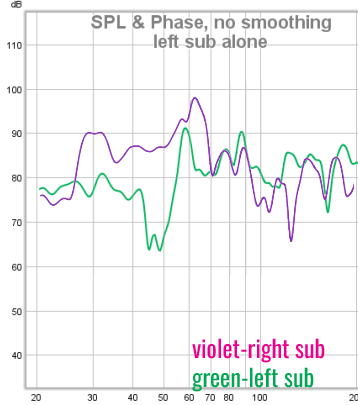
As you can see left channel has a HUGE dip that's impossible to equalize.
If we instead feed subs with mono signal, the result is much better. If one of the subs has inverted polarity, the frequency response is even better. We have no huge dips to speak of. Two subs with inverted polarity can be equalized to almost straight line and every bass note will sound the same way.

What's even better the bass is more even across the room. When I'm moving across the room I don't hear any obvious peaks. If subs are fed with stereo signal, there are places where some notes sound obviously louder than others. That's why I'm saying multiple subs fed with a mono signal is the way to go.
No, i do not mean it is good to have no bass, i ment subwoofers did not work for me bacause of poor sound quality of many recordings, for music reproduction i think it is better to use woofers that is to some point low frequency restricted then using subwoofers that has full output far down in the sub frequencies. And I blame the music industry for their lack of control

...many recordings seems not to go thru any sound quality control at all, and this is a major problem. I wish the music recording business had some of the quality control that movie business has. But home recordings seems to take us further and further away from that target
While the first part may be true, the movie industry has some control on the audio playback systems with performance criteria and such.
I dare say that we in the home audio world are at least equal or even more of a wild card than who mixed and mastered.
Just look at the vastly different playback systems here at DIY!
How many of is listen with REAL large format studio monitors?
Do you?
My best.
Barry.
i think large speakers/monitors are for high playback levels and i do not need that, i do most of my listening on floorstanding two ways and i sit fairly close. my main priorities are tonalty, clarity and depth. i do sometimes miss very deep notes, i will sometime try adding woofers to reach a bit lower in freq but i will not try subwoofers again 


Hello All,
What is your preferred way to add a sub-woofer(s)?
I am putting together a stereo system that will not always use a sub-woofer, you know late at night or your wife is reading downstairs kind of thing. Or you are listening to program material that has no Low Frequency Effects. But when you do, you want to kick it up to 11.
I am thinking of speakers without added sub-woofers with an f3 of 40Hz. For most program material they will work just fine without the added benefit of sub-woofers. Just saying, maybe JBL 2226’s, reflex enclosures with 5 ft3 volume tuned to 40Hz. (From the factory data sheet.)
I know some folks have a preference for sealed woofers. Is there a benefit in using sealed woofers when a sub-woofer will be switched in or out?
What kind of trouble will there be in terms of phase and, group delay or other issues if a sub-woofer(s) down to 20Hz is added?
Just trying to stir up a discussion!
Thanks DT
Hello again DT
My mains have an f3 of 40 Hz and in room extend down into the 30's. I tried some entry level Ryhtmik subs (2 x L12's) sealed and servo design. I wish I had purchased sooner... I listen to mostly rock , blues, and alternative - did not think there was much energy below 40 Hz on what I listened to, but I was wrong.
I use Audiolense with linear phase digital XO to cross to the subs. The software also time aligns the subs as there is significant delay (milliseconds) relative to the mains, even though they are sitting side by side. I also used this room mode calculator amroc - THE Room Mode Calculator to cross to the subs in between a room mode and ended up with a 45 Hz XO to the subs.
Wrote an article on it with measurements: Integrating Subwoofers with Stereo Mains using Audiolense - CA Academy - Audiophile Style
In that article, I tried a time domain experiment where the FIR correction filter I used had the same frequency response, but one had all of the drivers time corrected and the other did not. While not a huge difference, there is an audible difference where the time corrected filter had the best transient impact and perfectly clear sounding, whereas non-time corrected the subs sounded behind the mains...
I think highly of the Rythmik servo design (they have kits) having listened to many subs. So much so that I upgraded the entry level L12's to F18's to match the output of my system and very happy. Their transient response is as good as I have seen from any sub regardless of price. Some pic and measures here: Official Rythmik Audio Subwoofer thread - Page 1223 - AVS Forum | Home Theater Discussions And Reviews
With JRiver, you can use their surround sound mixing and determine how much LFE you want mixed into the 2 channel stereo while watching movies. You can also use their dynamic loudness control so that below reference level, you can get an increase in bottom end. Fully adjustable and once set, no worries. So no matter what listening level, it always sounds nice and full even at 65 db SPL. But you can always disengage the loudness control and/or turn the subs off for late night...
Hope you are having fun and looking forward to your M2 waveguide measurements!
Cheers,
Mitch
Hello All,
I have had a M&K dual 12 inch sub sitting here, a couple of days ago I connected the thing to a second pair of outputs on the pre-amp and fired up the sub. The 40Hz E on the bass guitar is really there and makes a real difference. I could hear it before, sort of, now it is real.
I like the idea of different presets for late night and or home alone kind of listening. So far I am limited to adjusting the sliders on the 30-band analog equalizer and twisting the knobs on the sub.
The mains are a variable homebrew pair of 3-way JBLs; 2204 woofers, 2119 mids and 2425H / 2344A waveguides. Each driver is in a separate enclosure. I am about ready to swap out the 2204’s for 2217’s or 2226’s. There is a pair of M2 waveguides here I intend to test drive. Mitch I will post the results.
I am down to working part time; my wife mostly is full time. We now have a second place up the coast we will call the full time home down the line. I have moved Sparky’s Lab (Sparky the Cat) to the new digs.
Next week I will be at the new place with the test equipment. The plan is to test TS / P on the new to me 2217 woofers and 2245 new recone sub. Also in the works is to test the M2 waveguide with the D2 drivers, 2451JSL and 2432
Thanks DT
I have had a M&K dual 12 inch sub sitting here, a couple of days ago I connected the thing to a second pair of outputs on the pre-amp and fired up the sub. The 40Hz E on the bass guitar is really there and makes a real difference. I could hear it before, sort of, now it is real.
I like the idea of different presets for late night and or home alone kind of listening. So far I am limited to adjusting the sliders on the 30-band analog equalizer and twisting the knobs on the sub.
The mains are a variable homebrew pair of 3-way JBLs; 2204 woofers, 2119 mids and 2425H / 2344A waveguides. Each driver is in a separate enclosure. I am about ready to swap out the 2204’s for 2217’s or 2226’s. There is a pair of M2 waveguides here I intend to test drive. Mitch I will post the results.
I am down to working part time; my wife mostly is full time. We now have a second place up the coast we will call the full time home down the line. I have moved Sparky’s Lab (Sparky the Cat) to the new digs.
Next week I will be at the new place with the test equipment. The plan is to test TS / P on the new to me 2217 woofers and 2245 new recone sub. Also in the works is to test the M2 waveguide with the D2 drivers, 2451JSL and 2432
Thanks DT
I have an active sub on my system. The pre-amp/power supply - Naim NAC72/Hi-Cap has two outputs; one goes to the NAP250, the other to the sub.
The sub also has a passive crossover as the sub amp (BK300) cut off isn't that good. Bass is felt as well as heard.
Anyway, a few nights ago I was listening to some late night Jazz. Everything sounded as it should. It wasn't until I went to get the disc and turn things off that I noticed the sub wasn't turned on. I would have noticed it missing with other material but the mains had enough extension for what I was listening to.
Bass on the mains is provided by a SEAS L18 and the cabinet is ported. Below is a view of the whole lot in my tiny AV room/music room/man cave.
The sub also has a passive crossover as the sub amp (BK300) cut off isn't that good. Bass is felt as well as heard.
Anyway, a few nights ago I was listening to some late night Jazz. Everything sounded as it should. It wasn't until I went to get the disc and turn things off that I noticed the sub wasn't turned on. I would have noticed it missing with other material but the mains had enough extension for what I was listening to.
Bass on the mains is provided by a SEAS L18 and the cabinet is ported. Below is a view of the whole lot in my tiny AV room/music room/man cave.
Attachments
- Status
- This old topic is closed. If you want to reopen this topic, contact a moderator using the "Report Post" button.
- Home
- Loudspeakers
- Multi-Way
- Your preferred way to add a sub-woofer(s)?
